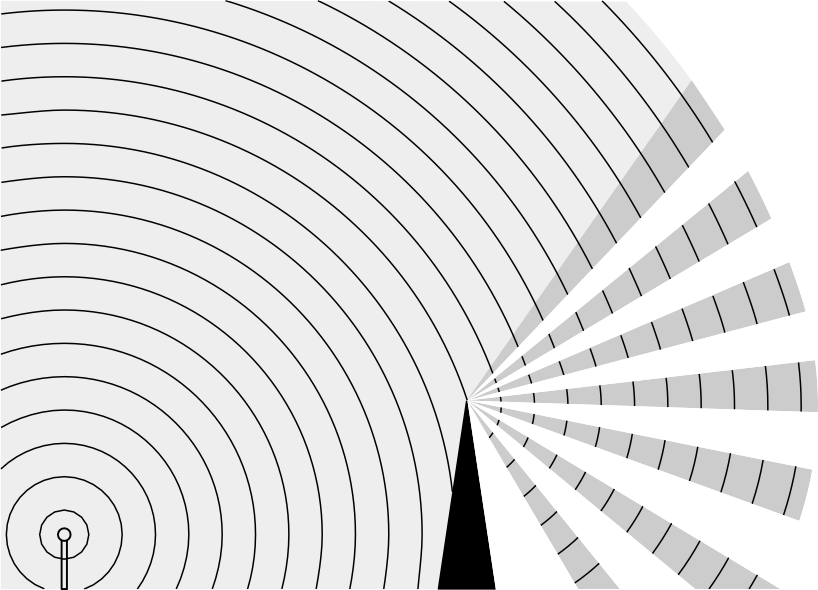Knife-Edge Diffraction
Radio waves can also pass behind solid objects with sharp upper edges, such as a mountain range, by knife-edge diffraction. This is a common natural phenomenon that affects light, sound, radio and other coherent waves, but it is difficult to comprehend. Fig 21.4 depicts radio signals approaching an idealized knife-edge. The portion of the radio waves that strike the base of the knife-edge is entirely blocked, while that portion passing several wavelengths above the edge travel on relatively unaffected. It might seem at first glance that a knife-edge as large as a mountain, for example, would completely prevent radio signals from appearing on the other side but that is not quite true. Something quite unexpected happens to radio signals that pass just over a knife-edge.
Normally, radio signals along a wave front interfere with each other continuously as they propa- gate through unobstructed space, but the overall result is a uniformly expanding wave. When a portion of the wave front is blocked by a knife-edge, the resulting interference pattern is no longer uniform. This can be under-
 stood by
visualizing the radio signals right at the knife-edge as if they
constituted a new and separate transmitting point, but in phase with
the original source. The signals adjacent to the knife-edge still
interact with signals passing above the edge, but they cannot interact
with sig- nals that have been ob- structed below the edge. The
resulting interference pat- tern no longer creates a uni- formly
expanding wave front, but rather appears as a pattern of alternating
strong and weak bands of waves that spread in a nearly 180º arc be-
hind the knife-edge.
stood by
visualizing the radio signals right at the knife-edge as if they
constituted a new and separate transmitting point, but in phase with
the original source. The signals adjacent to the knife-edge still
interact with signals passing above the edge, but they cannot interact
with sig- nals that have been ob- structed below the edge. The
resulting interference pat- tern no longer creates a uni- formly
expanding wave front, but rather appears as a pattern of alternating
strong and weak bands of waves that spread in a nearly 180º arc be-
hind the knife-edge.
The crest of a range of hills or mountains 50 to 100 wave- lengths long can serve as a reasonable knife-edge dif- fractor at radio frequencies. Hill crests that are clearly
Fig 21.4—Radio, light and other waves are diffracted around the sharp edge of a solid object that is large in terms of wavelengths. Diffraction results from interference between waves right at the knife-edge and those that are passing above it. Some signals appear behind the knife-edge as a consequence of the interference pattern. Hills or mountains can serve as natural knife-edges at radio frequencies.
defined and free of trees, buildings and other clutter make the best edges, but even rounded hills may serve as a diffracting edge. Alternating bands of strong and weak signals, corresponding to the interference pattern, will appear on the surface of the Earth behind the mountain, known as the shadow zone. The phenomenon is generally reciprocal, so that two-way communication can be established under optimal conditions. Knife-edge diffraction might make it possible to complete paths of 100 km or more that might otherwise be entirely obstructed by mountains or seemingly impossible terrain.
